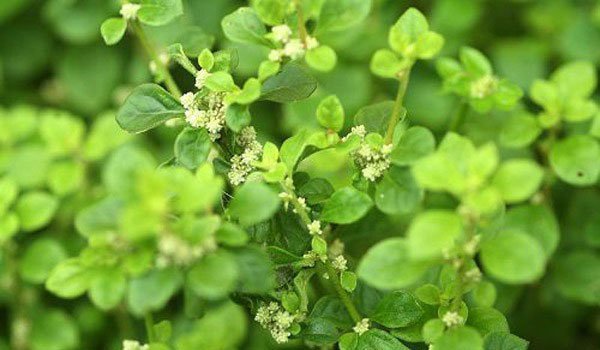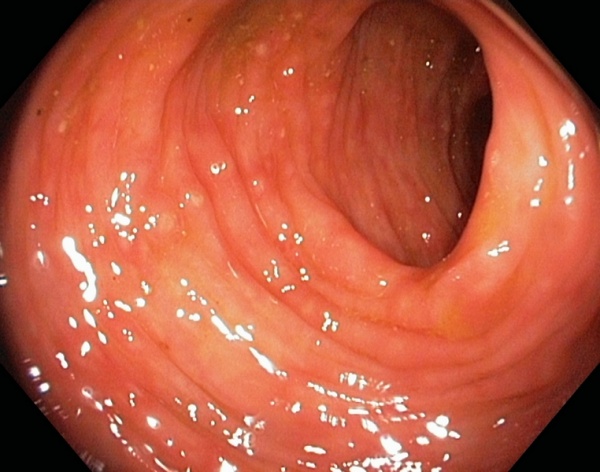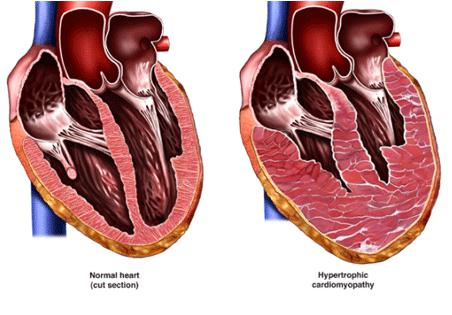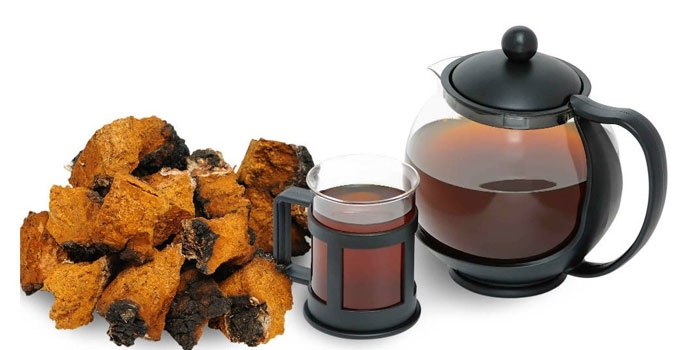How to get rid of calluses on the legs: home and pharmacy remedies, professional methods
Human feet experience stress every day. They perform a supporting function, ensure the safety of movement, absorb impacts on the ground when walking or running, unload the spine and leg joints. Improper care for them, uncomfortable shoes, overweight, flat feet, incorrect gait and other factors increase the load on the feet and lead to its uneven distribution, which often ends in the formation of corns. In addition to the ugly appearance, these formations cause discomfort when walking, so you need to get rid of them in the initial stages.
- wet;
- dry;
- rod.
wet calluses
Wet corns are also called water or soft. They look like vesicles filled with a colorless or yellowish lymphatic fluid. Despite the fact that this type of corns is accompanied by the most unpleasant sensations and acute pain, they are the easiest to get rid of without a trace in the shortest possible time. They usually occur due to severe rubbing of the skin with unsuitable or new shoes.
In rare cases, in the presence of capillaries located close to the surface of the skin and their damage, the contents of the vesicle have a reddish color.
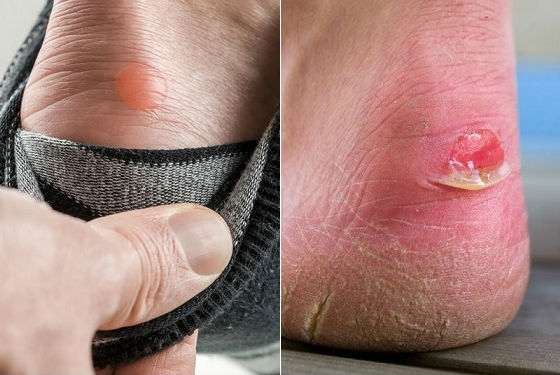
dry corns
The first stage in the formation of dry callus is corns - a slight swelling and redness of the skin. Over time, it coarsens, loses sensitivity, becomes smooth or, conversely, rough to the touch, acquires a yellow or gray color, and can be covered with cracks of various depths.
Dry calluses are formed with an unevenly distributed load on the foot, most often at the bases and on the balls of the toes due to systematic long-term pressure on the skin of the feet. These thickenings of the surface layer of the epidermis, consisting of dead cells due to impaired blood circulation, can cause a burning sensation and pain when walking.
Interesting: Calluses in women are 10 times more common than in men, which is primarily due to long-term wearing of high-heeled shoes.
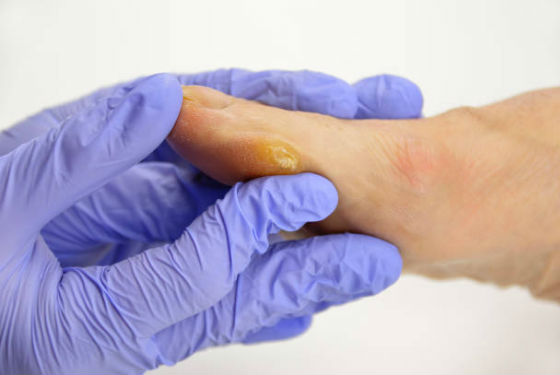
Corns
Calluses consist of a cap and a hard root (rod) that penetrates deep skin layers and causes pain when pressed and walking. In appearance, they are a small bulge on the skin with a hole resembling a wound approximately in the center, where the rod is located. If the root is located near the nerve endings, then it can compress them, causing severe pain that makes it impossible for a person to fully stand on his foot.
Calluses arise as a result of constant mechanical action on a certain area of the skin or skin damage by a virus that disrupts the normal process of periodic exfoliation of dead cells. Most often they are localized in the area of the thumb, little finger or in the interdigital spaces, as well as on the heel.

Basic principles of treatment of corns
The tactics of treating corns is determined by its type. However, it is very important to find out the reason why it was formed and try to eliminate it. It may be necessary to change shoes for more comfortable ones, lose weight, correct gait, visit an orthopedist, use special orthopedic insoles.
Wet corn in the absence of infectious complications and damage to the capillaries is treated at home. To do this, you just need to treat it with an antiseptic (brilliant green, iodine), seal it with a breathable patch and take measures to eliminate factors that injure the painful place. She will heal on her own in a few days.
It is strongly not recommended to pierce the corn, and even more so to cut off the film remaining from the top after removing the liquid from the skin. It performs a protective function and prevents microbes and dirt from entering the wound underneath.
Treatment of dry corns should be started as early as possible, since it is in the initial stages that it is easier to deal with them with the help of home remedies, special ointments, creams and patches.

Corns are the most difficult and it is impossible to effectively get rid of them on your own at home. To avoid complications, the removal of such formations is carried out in a medical institution by a specialist with experience in this field.
Important: Before starting the treatment of corns, you need to consult a doctor, since the keratinized skin on the feet may not be a corn, but a completely different formation, such as a wart.
Folk remedies for corns and dry corns
From folk remedies for getting rid of corns, baths with herbal decoctions, sea salt and soda, masks and compresses with vegetable oils, medicinal plants, pulp of vegetables and fruits are used. It may take a long time to get good results and the complete disappearance of rough skin layers.
Bath with baking soda and liquid soap
Compound:
Water - 3 l
Soda - 3 tbsp. l.
Liquid soap - 1 tbsp. l.
Application:
Pour warm water into a bowl, add soda and liquid soap, mix. Soak your feet in the resulting bath for 20-30 minutes. After the rough skin softens, use a pumice stone, a special brush or file to try to remove it as much as possible. Then rinse your feet, dry with a towel and massage your feet with a moisturizing or softening cream.

Potato compress
Pre-steam the legs in a bath with salt and iodine. To prepare it for 2 liters of water, you need to take 3 tbsp. l. salt and 2 tsp. iodine. Peel the raw potatoes, grate and apply to the corn, fix on top with a film and a bandage or a wide band-aid, leave overnight. In the morning, remove the softened skin layer with a pumice stone, wash your feet and apply a nourishing cream.
Remedy for dry corns and prevention of cracked heels
Compound:
Glycerin - 50 ml
Ammonia - 10 drops
Application:
Add ammonia to glycerin and mix thoroughly. Before going to bed, apply the mixture on the feet, put on cotton socks and go to bed. In the morning, wash your feet with soap and water to remove glycerine residue and scrub with a pumice stone.
Dandelion juice for corns
Dandelion juice, collected during the flowering period, is an effective remedy for getting rid of dry corns. It must be applied in the following way. An incision is made on the stem of the plant, the resulting juice is applied to the rough skin until it dries up, with a lack of juice, cuts on the dandelion stem are made in other places.
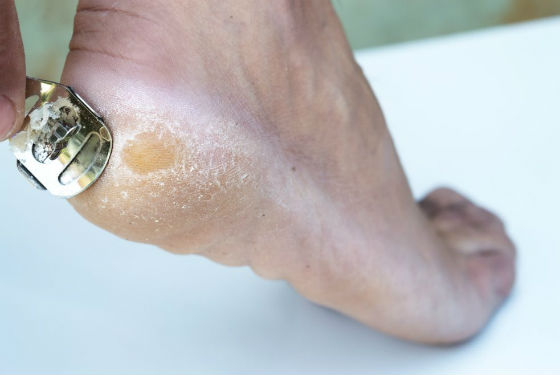
Callus mask with blue clay
Compound:
Blue clay - 4 tbsp. l.
Castor oil - 50 ml
Application:
Mix clay with castor oil. Heat the mixture in a water bath with constant stirring until the mass acquires the consistency of sour cream. In a warm form, apply the mask only on the problem areas of the feet, wrap the legs with a dense natural cloth and leave for 15 minutes. Then remove the rest of the mask with a tissue and wash your feet with warm water. This procedure should be repeated 2-3 times a week.
Ivy leaf remedy
Rinse fresh ivy leaves with running water and grind with a blender to a gruel state. Apply the mass on the corn, wrap it with cling film and a bandage on top. Perform for 3-5 days before bed.
Propolis for painful calluses
In the evening, soak your feet in a warm bath. Knead a piece of propolis suitable for the size of the corn with your hands and attach it to the problem area, fix it with a band-aid. In the morning, remove propolis and scrape softened skin with a pumice stone. The procedure must be repeated several times until the corn is completely eliminated.
Dry fruit compress
Prunes or figs are slightly boiled. Before going to bed, on the steamed legs to the calluses, attach the fruits cut in half with the inside and secure them with a bandage. Repeat daily for a week or longer until the callus is completely removed with a pumice stone.

Oatmeal mask for corns
Pour boiling water over oatmeal. Apply the resulting swollen mass at night in a thick layer on the area of the skin of the feet with calluses, wrap with cling film. Wear cotton socks over the top. In the morning, wash your feet with warm water, rub with a pumice stone and apply a moisturizer.
Aloe compress
After taking a hot bath or taking a foot bath, apply a piece of aloe leaf, cut in half lengthwise, to the calluses with the inside. Fix it with a band-aid and leave overnight. In the morning, remove the already softened keratinized skin with a pumice stone.
Pharmacy funds
To eliminate corns and dry calluses, you can use special products sold in pharmacies. They are available in the form of a patch, solutions, creams or ointments. The main active ingredients of these drugs are salicylic and lactic acids, which have a pronounced keratolytic effect. They help soften the calluses and facilitate their separation. Additionally, these products may contain sulfur, urea, oils, plant extracts. The most famous and used of them for removing corns are:
- solution "Collomak";
- patch "Salipod";
- cream "Namozol";
- plaster "Compid";
- liquid "Stopmozol";
- cream "Super Antimozolin" and others.

Important: When applying pharmacy remedies for corns, you should strictly follow the instructions attached to them and avoid getting them on healthy areas of the skin, as they cause inflammation and burns there.
Professional callus removal methods
You can get rid of dry and calluses on the legs with the help of a hardware pedicure in a beauty salon. The essence of the method is to remove rough skin by drilling with a special device equipped with nozzles of various diameters. The advantage of this method is the absence of pain and injury to surrounding tissues. In the case of callus, an anti-inflammatory agent is placed in the hole formed after drilling, which promotes rapid tissue regeneration.
You can also get rid of calluses with a rod using cryodestruction. During the procedure, the problem area is treated several times for 20-30 seconds with liquid nitrogen, the duration and frequency of exposure depends on the depth of the rod. As a result of cryodestruction, the treated area of the skin becomes unviable, turns white and is rejected after a few days, and healthy skin appears under it. During the entire time until the skin is completely healed, it is necessary to carefully care for the wound and treat it with antiseptic agents to prevent infection.
Laser therapy is considered the most effective way to get rid of dry and core calluses. The procedure is performed under local anesthesia. When exposed to the corn, the laser beam heats it up and evaporates pathologically altered tissues or causes them to coagulate, without touching the healthy ones. At the end of the process, a small wound remains on the skin, which quickly heals without a trace.
Video: Tips for the prevention and treatment of corns from a pedicure master
- Intercostal neuralgia - what is it and how to treat
- How to quickly get rid of dry corns on the legs
- How to treat left ventricular hypertrophy
- Rating of the best drugs for rotavirus for children
- Making tea from currant leaves, the benefits and harms of the drink
- How to drink hydrogen peroxide according to Neumyvakin - an oral regimen
- Features of the treatment of plantar fasciitis with folk remedies
- The composition and beneficial properties of parsley root
- How to get pregnant quickly? Folk remedies
- Herbs-ants in the "pot-bellied" period or the use of herbal medicine during pregnancy
- Why does a sore throat and dry cough occur, and what treatment is required?
- Guy's Room Design: Ideas and Examples
- General rules for drawing up a foundation plan House foundation drawings
- modern art deco bedroom small art deco bedroom
- Pansies: characteristics and photos of flowers
- Making an art deco bedroom: the choice of materials Beige art deco bedroom
- Bedroom interiors in art deco style Bedroom art deco style beige
- Young: planting and care in the open field Young planting and care in the open
- Varieties for open ground
- Pansies: cultivation and care in the open field




